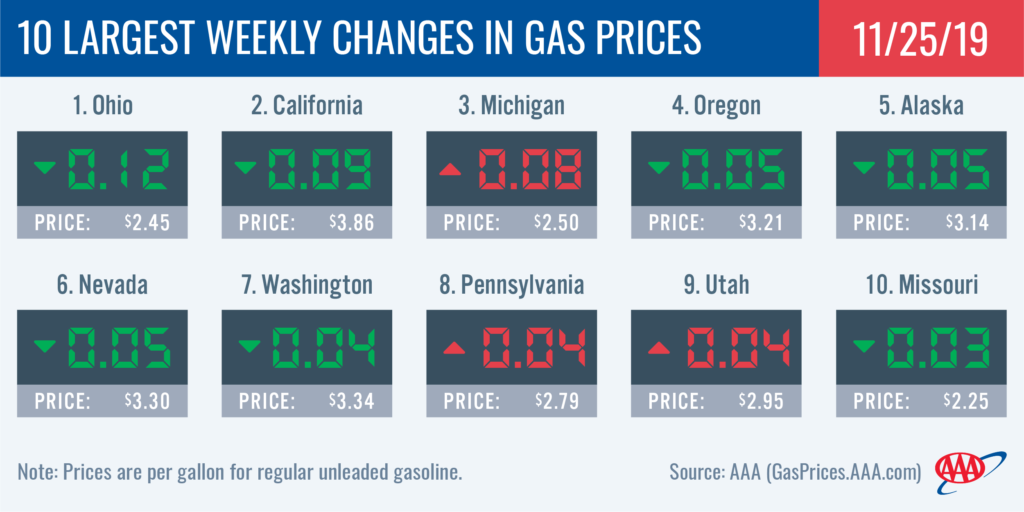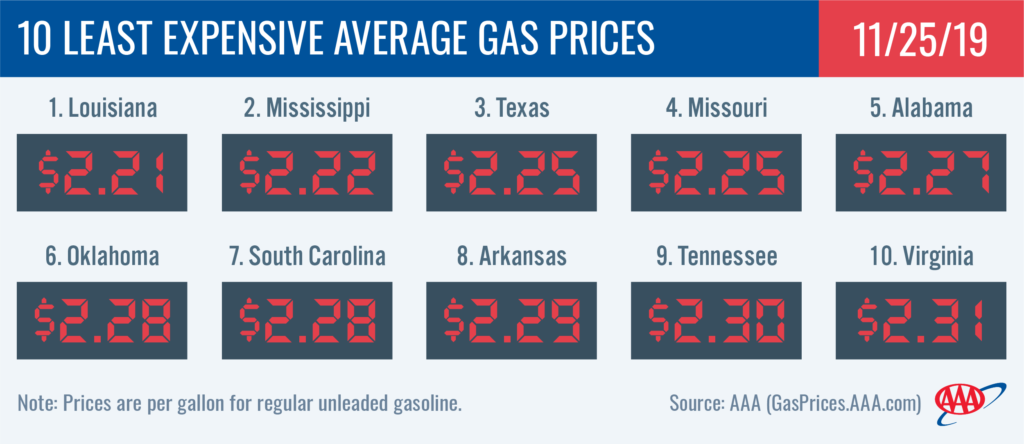[ad_1]

 For the 49 million Americans hitting the road for the Thanksgiving holiday, they will find gas prices mostly similar, if not cheaper, than last year’s holiday. Today’s national average is $2.59. That is just a few cents over the 2018 holiday weekend average of $2.57.
For the 49 million Americans hitting the road for the Thanksgiving holiday, they will find gas prices mostly similar, if not cheaper, than last year’s holiday. Today’s national average is $2.59. That is just a few cents over the 2018 holiday weekend average of $2.57.
“During Thanksgiving week last year we saw the national gas price average decrease a nickel between Monday and Thursday, that could be the case again this year,” said Jeanette Casselano, AAA spokesperson. “AAA recommends holiday road-trippers use the AAA app to find current gas prices along their route.”
Today, 61% of all gas stations in the country are selling regular unleaded for $2.50 or less. On the week, gas prices are flat.
Quick Stats
- The nation’s top 10 least expensive markets are: Louisiana ($2.21), Mississippi ($2.22), Texas ($2.25), Missouri ($2.25), Alabama ($2.27), Oklahoma ($2.28), South Carolina ($2.28), Arkansas ($2.29), Tennessee ($2.30) and Virginia ($2.31).
- The nation’s top 10 largest weekly changes are: Ohio (-12 cents), California (-9 cents), Michigan (+8 cents), Oregon (-5 cents), Alaska (-5 cents), Nevada (-5 cents), Washington (-4 cents), Pennsylvania (+4 cents), Utah (+4 cents) and Missouri (-3 cents).
Mid-Atlantic and Northeast
States in the Mid-Atlantic and Northeast region carry some of the largest year-over-year gas price savings with six state averages at least a dime cheaper than last Thanksgiving week. This includes: Connecticut (-19 cents), Rhode Island (-17 cents), New York (-15 cents), Vermont (-14 cents), New Hampshire (-15 cents) and Washington, D.C. (-11 cents). However, motorists filling up in Delaware (+12 cents), Maryland (+5 cents) and Pennsylvania (+3 cents) are paying more than this time last year.
On the week, gas prices are relatively flat with most states seeing gas prices decrease a few cents. Pennsylvania (+4 cents) and Virginia (+1 cent) were the only states to see pump prices increase.
Motorists could see some small increases at the pump as we get closer to Thanksgiving and heavy travel times. An increase could also be the result of decreasing stocks in the region. The latest Energy Information Administration (EIA) report shows a draw of 1.78 million bbl which brings the current total stock to 58.3 million bbl.
Great Lakes and Central States
Gas prices are more expensive compared to this time last year for 9 of the 13 Great Lakes and Central states, with these four state averages a dime or more higher: Illinois (+16 cents), Ohio (+16 cents), Indiana (+15 cents) and Michigan (+11 cents). Four other states have more expensive prices, but not in the double-digits: Kentucky (+8 cents), Iowa (+7 cents), Missouri (+7 cents), Nebraska (+6 cents) and Kansas (+4 cents).
On the week the majority of states saw a decrease or no change in gas prices. This was due to gasoline stocks holding steady at 46.4 million bbl and a one percent increase in regional refinery utilization. However, two states did see prices increase on the week: Michigan (+9 cents) and Wisconsin (+2 cents). If refinery rates increase to help build stocks, most motorists in the region could expect gas prices to be cheaper through year-end.
South and Southeast
Heading into the holiday weekend, states in the South and Southeast tout the cheapest gas prices in the country, including the top 8 of the 10 least expensive averages in the country: Louisiana ($2.21), Mississippi ($2.22), Texas ($2.25), Alabama ($2.27), South Carolina ($2.28), Oklahoma ($2.28), Arkansas ($2.29) and Tennessee ($2.30). New Mexico ($2.50) carries the most expensive average in the region.
Oklahoma (+6 cents), South Carolina (+4 cents), Georgia (+4 cents) and Texas (+1 cent) are the only states in the South and Southeast with gas prices more expensive than a year ago. The other seven states carry cheaper year-over-year gas price averages between one and six cents.
With a 2.1 million bbl increase, regional gasoline stocks sit at a healthy 80.6 million bbl. The build was aided by a 3% increase in regional refinery utilization. The EIA has not measured stock levels or regional refinery rates at these high levels for the South and Southeast region since early October and end of September, respectively. This combination should cause gas prices to decrease following the Thanksgiving holiday.
West Coast
Pump prices are continuing to decline in the region after prices spiked due to planned and unplanned refinery maintenance over the past month. Increased gasoline stocks have helped to put downward pressure on pump prices, as demand remains robust. According to EIA’s report for the week ending on November 15, gas stocks in the region grew by a hefty 1.9 million bbl, bringing the total to 28.49 million bbl. The current supply level is 1.6 million bbl higher than last year’s level at this time, which should continue to help prices decline ahead of the busy Thanksgiving holiday.
California ($3.86) and Hawaii ($3.65) are the most expensive markets in the country. Washington ($3.34), Nevada ($3.30), Oregon ($3.21), Alaska ($3.14) and Arizona ($2.92) follow. All averages have declined on the week in the region, with California (-9 cents) seeing the largest drop.
Rockies
Filling-up in the Rockies states during the Thanksgiving holiday will be more expensive for some motorists while others will be paying less for gas than they did at this time last year. State gas price averages rank between the 7th and 13th highest in the country. Two states are within a nickel or less of hitting $3/gal: Idaho ($2.97), Utah ($2.95), Colorado ($2.79), Wyoming ($2.73) and Montana ($2.69).
Compared to last year’s holiday, Colorado (+12 cent) and Utah (+3 cents) have more expensive averages. Meanwhile motorists in Montana (-17 cents) and Wyoming (-14 cents) are paying a lot less than last year. Idaho’s average is consistent with a year ago.
Gas prices are likely only to see minimal fluctuation in the week ahead. The latest EIA data shows stock levels at 6.9 million bbl, which is a healthy level for the region at this time of year.
Oil Market Dynamics
At the close of Friday’s formal trading session on the NYMEX, WTI decreased by 81 cents to settle at $57.77. However, crude prices increased slightly in recent reports (about a nickel) due to reports that the Organization of the Petroleum Exporting Countries (OPEC) and its partners are likely to extend their current production reduction agreement through the middle of 2020 at OPEC’s meeting in Vienna on December 5 – 6. Price gains were limited by continued market fear that the trade war between China and the U.S. – the world’s two largest crude consumers – will reduce crude demand moving into next year. If trade tensions increase this week, crude prices could decrease further.
In related news, EIA’s weekly report showed that total domestic crude inventories increased by 1.4 million bbl last week, bringing the new total to 450.4 million bbl. The current level is 3.5 million bbl higher than last year’s level at this same time.
Motorists can find current gas prices along their route with the free AAA Mobile app for iPhone, iPad and Android. The app can also be used to map a route, find discounts, book a hotel and access AAA roadside assistance. Learn more at AAA.com/mobile.
[ad_2]
AAA Newsroom Source link












